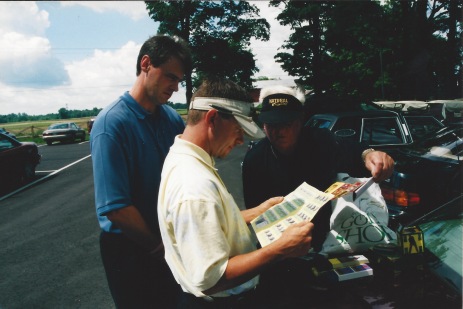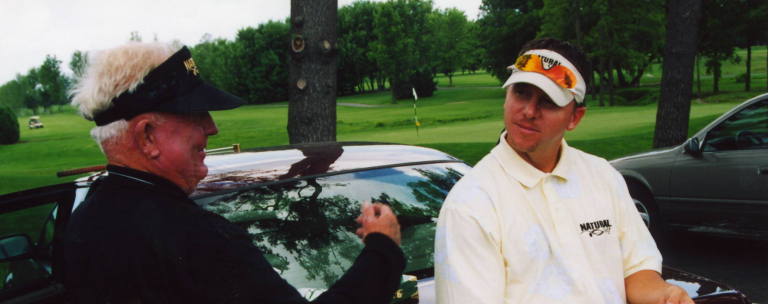“I don’t know how to hit it badly”
Moe said this to me many times. I think this is an important quote.
When I asked him how he learned his perfect golf swing, he also said: “It’s hard work, you can’t buy it.”

I don’t mean to get too spiritual with this blog but Moe’s quote makes me think of Yoda or maybe even Buddha. You might even consider Moe’s golf swing, or at least the recognition of his achievement, as a type of enlightenment.
It wasn’t a question of whether Moe would make a right or wrong swing. His golf swing was sort of well, golf nirvana. But early on he had to work for it. He told me it took him five years between the ages of fourteen and nineteen to get there. We should probably ask
“What happened in those 5 years”?
When Moe was alive, I would sometimes travel to visit him in his hometown of Kitchener, Ontario. I spent some time doing a bit of research. I was interested in Moe’s life and where he occupied his time away from the golf course. I wanted to look behind the curtain at Moe. On one visit as I was digging through some archives in the local library, I came across a research paper.
Moe was part of a study done by Janice Starkes, Janice Deakin and Fran Allard called “Deliberate Practice, what is it anyway?” Because of his incredible ability to strike a golf ball, Moe was a subject of the study and was interviewed. The study defines “deliberate practice”:
That deliberate practice according to the study “is not “play,” not paid work, not watching the skill he performed, not inherently enjoyable, requires effort and attention from the learner, and often involves activities selected by a coach or teacher to facilitate learning.”
An essential element of the study is that time spent in practice is a critical determinant of the level of performance. Moe, who joined Rockway at age 14 and started practicing at age 16, began competing at age 19. According to the study, Moe had “no real teachers and took no formal lessons, essentially working out his swing on his own.” The systematic practice was Moe, standing in a field hitting balls to hone his swing. The study notes that Moe’s routine between ages 19 to 32 was to hit 800 balls per day on weekdays when he had to go to work and then play 54 holes on Saturday and 72 holes on Sunday.
If you roughly do the math and take in consideration Canadian winters that last approximately 5 months, that leaves about 210 Canadian golf days. Multiply 210 days’ times 800 golf balls, and you get 840,000 golf balls struck.
(As a side note, I rarely see that type of work ethic today. Our culture seems to think that technological advances can substitute the need for repetition. I don’t know if anything can replace repetition.)
Moe’s repetitive work, as compulsive as it may have been, developed his golf swing which is no different than any other physical skill such as dance or martial arts.
In an article from Men’s Health Magazine, Jet Li, a master of Martial Arts and actor discusses this same phenomenon. In the article, he talks about learning the art forms and talks about mastery as a three-level process.
Level one: Learn the forms-and repeat them endlessly. “Use your body as a weapon,” Li says. “And you need to use the weapons very well, [so you] concentrate on skill.” Level two: Physical technique is now innate, so psychological tools come to bear. “I don’t need to fight if I can scare you, or use my heart to convince you,” says Li. Level three: You gain a mastery of inner peace so that you no longer need to raise a hand. “We sit here, everybody feels safe, and I’m not scared of aggression. It’s close to religion, like Jesus. They beat me up, fine. But slowly they understand, and they drop their weapons. They don’t want to fight anymore.” – Men’s Health Magazine
It is Jet Li’s level one that very few people get to. You can’t get to level one if you aren’t willing to work and technology won’t help you get there either. Playing at an even higher level requires Level Two. This is where you find most tour players. In my opinion, Moe reached Level Three. This is the place where, as Li says, “you gain a sense of inner peace.”
Moe said, “I don’t know how to swing it severely.” He might just have said I’m not worried, I got it. I don’t know how to fail.”
There is a sense of peace in Moe’s confidence about his swing, but this feeling of peace came at a price. Moe hooked the ball when he was younger. He struggled and had to work at it. It was perfect for me to learn about Moe’s trial and error process. Knowing more about those learning years is extremely important. Finding that Moe struggled and went through a similar process that all of us must go through, is also reassuring to those who are learning Moe’s way.
I believe it was Moe’s state of mind that helped him solve the golf swing equation. In other words, it is HOW Moe answered the hook and what he was focused on that lead to Moe becoming the greatest ball-striker ever to play the game. That is what all of us can learn from. Moe didn’t beat himself up when he had a rough day of practice. It was quite opposite:
“I am my own best friend. I treat myself well “Moe would say. This might be the only lesson we need”.
I have also learned that you have to be careful when you talk to a master. They see the world from a higher perspective. Their view of the horizon is at the top of the mountain and not at the bottom where most of the people stand.
Our swing discussions referred to the movement of the golf club and club face. His awareness had moved well beyond the fundamentals of the grip and address.
Just as Buddha saw the world from a place of “detachment,” Moe saw the golf swing from a place of “Greatness.” As with all masters, they leave us clues even if they are sometimes cryptic. Moe left us clues regarding his golf swing.
“No twisting and turning,” Moe said, “Look, you could eat off of the face” referring to the club-face through impact. “Up and never around, like a pendulum,” was another one of Moe’s ways of describing the movement of the club.
Many of you are searching for your golf nirvana. I did the same thing. The most important thing you can do right now is to copy the Master simply. Use his swing as the model and treat yourself well – become your own best friend. I guarantee you that it will be hard work as Moe said but it will be well worth it.
We can thank Moe for that.

Somewhere along the way to learning this perfect swing as quickly as possible, I slowed down and embraced the process.
Bruno Ammann Swiss Watch Repair 303-359-0707
LikeLike
Yes. Thank you Bruno!
LikeLike
What a fantastic article! Thank you for sharing that interesting insight into Moe’s early years. I have always used Moe as my inspiration, motivation, and reason for “never giving up”. There are a lot of things we can learn from Moe that not only apply to golf but our everyday lives as well. I think Moe’s greatest accomplishment was finally finding peace and understanding in a complicated world he once found so foreign. As his close friend Paul Bertholy once said, “Only the lazy ones fail”. We can accomplish any goal we set our minds to. We just have to stick with it.
LikeLike
Thank you Chris!
LikeLike
I’ve been playing golf for over 55 years and THAT is probably the best article about golf I’ve seen. Likely because I relate to it having a martial arts background. But more importantly, the value of repetition done correctly. So many of us practice to “get it right” and Moe practiced so he couldn’t get it wrong. Thank you!
LikeLike
Thanks Bruce! Yes, he practiced “deliberately” and “deeply”. I think practice is a skill too.
Todd
LikeLike